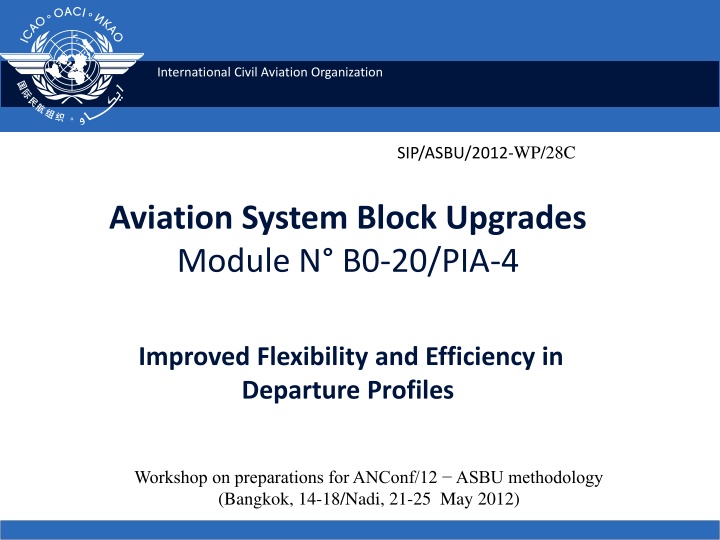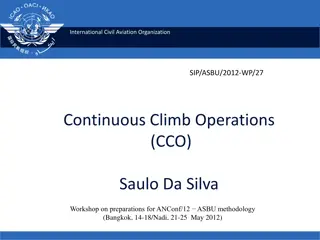
Improved Flexibility and Efficiency in Aviation Departure Profiles
Learn about Module N.B0-20's implementation of Continuous Climb Operations with Performance-Based Navigation (PBN) to enhance throughput, flexibility, and fuel-efficient climb profiles at congested terminal areas. Discover the benefits of increased airspace efficiency and reduced emissions through this innovative approach.
Download Presentation

Please find below an Image/Link to download the presentation.
The content on the website is provided AS IS for your information and personal use only. It may not be sold, licensed, or shared on other websites without obtaining consent from the author. If you encounter any issues during the download, it is possible that the publisher has removed the file from their server.
You are allowed to download the files provided on this website for personal or commercial use, subject to the condition that they are used lawfully. All files are the property of their respective owners.
The content on the website is provided AS IS for your information and personal use only. It may not be sold, licensed, or shared on other websites without obtaining consent from the author.
E N D
Presentation Transcript
International Civil Aviation Organization SIP/ASBU/2012-WP/28C Aviation System Block Upgrades Module N B0-20/PIA-4 Improved Flexibility and Efficiency in Departure Profiles Workshop on preparations for ANConf/12 ASBU methodology (Bangkok, 14-18/Nadi, 21-25 May 2012)
Module N B0-20 Improved Flexibility and Efficiency in Departure Profiles To implement Continuous Climb Operations in conjunction with PBN to provide opportunities to optimize throughput, improve flexibility, enable fuel-efficient climb profiles and increase capacity at congested terminal areas. KPA-04 Efficiency; KPA-05 Environment; KPA-10 - Safety Summary Main Performance Impact Operating Environment/Phases of Flight Departure and En-Route Global Concept Component(s) AUO Airspace user operations TS Traffic synchronization AOM Airspace organization and management GPI 5- RNAV/RNP (Performance. Based Navigation) GPI-10- Terminal Area Design and Management GPI-11- RNP and RNAV SIDs and STARs NIL Global Plan Initiatives (GPI) Pre-Requisites Status Ready Ready Ready Ready Ready Ready Global Readiness Checklist Standards Readiness Avionics Availability Infrastructure Availability Ground Automation Availability Procedures Available Operations Approvals ICAO SIP 2012-ASBU WORKSHOP 2
Module N B0-20 - Baseline Varies from one State/region to the next. Some aspects of the movement to PBN have already been subject of local improvements in areas ICAO SIP 2012-ASBU WORKSHOP 3
Module N B0-20 Change Brought by the Module RNAV; RNP where possible and needed PBN SIDs Increased efficiencies in terminal separation rules Effective airspace design and classification Continuous Climb Operations CCO is an aircraft operating technique aided by appropriate airspace and procedure design and appropriate ATC clearances A CCO can be flown with or without the support of function of the flight management system (FMS)) and with or without a fixed lateral path. ICAO SIP 2012-ASBU WORKSHOP 4
Module N B0-20 Intended Performance Operational Improvement Cost savings through reduced fuel burn and efficient aircraft operating profiles.; Reduction in the number of required radio transmissions. Authorization of operations where noise limitations would otherwise result in operations being curtailed or restricted. Efficiency Environment Environmental benefits through reduced emissions. More consistent flight paths. Safety Lower pilot and Air Traffic Control workload. CCO benefits are heavily dependent on each specific ATM environment. If implemented within the ICAO CCO manual framework, the benefit/cost ratio (BCR) will be positive. CBA ICAO SIP 2012-ASBU WORKSHOP 5
Module N B0-20 Necessary Procedures (Air & Ground) The ICAO Performance-based Navigation Manual (Doc 9613)-Provides general guidance on PBN implementation The Continuous Climb Operations (CCO) Manual (Doc xxxx); Provides guidance on Airspace design Instrument flight procedures ATC facilitation Flight techniques necessary to enable CC0s ICAO SIP 2012-ASBU WORKSHOP 6
Module N B0-20 Necessary System Capabilities Avionics CCO does not require specific air/ground technology. CCO is an aircraft operating technique aided by appropriate airspace and procedure design, and appropriate ATC clearances Ground systems Controllers would benefit from some automation support to display aircraft capabilities in order to know which aircraft can do what ICAO SIP 2012-ASBU WORKSHOP 7
Module N B0-20 Training and Qualification Requirements Training in the operational standards and procedures are required for this module Likewise, the qualifications requirements are identified in the regulatory requirements ICAO SIP 2012-ASBU WORKSHOP 8
Module N B0-20 Regulatory/standardization needs and Approval Plan (Air and Ground) Regulatory/Standardization Use current published requirements Approval Plans Must be in accordance with application requirements ICAO SIP 2012-ASBU WORKSHOP 9
Module N B0-20 Reference Documents Standards: Nil Procedures ICAO Doc 4444, Procedures for Air Navigation Services Air Traffic Management. ICAO Doc 9613, Performance-based Navigation (PBN) Manual; ICAO Doc xxxx, Continuous Climb Operations (CCO) Manual Approval Documents ICAO Doc XXXX, Continuous Climb Operations Manual; ICAO Doc 9613, Performance Based Navigation Manual; ICAO Doc 4444, Procedures for Air Navigation Services Air Traffic Management. ICAO SIP 2012-ASBU WORKSHOP 10
Module N B0-20 Implementation - Benefits and Elements Improved Flexibility and Efficiency in Departure Profiles Benefits: Efficiency, Environment and Safety Elements: CCO and PBN SIDs No avionics or Ground systems required To be reflected in ANRF ICAO SIP 2012-ASBU WORKSHOP 11




















